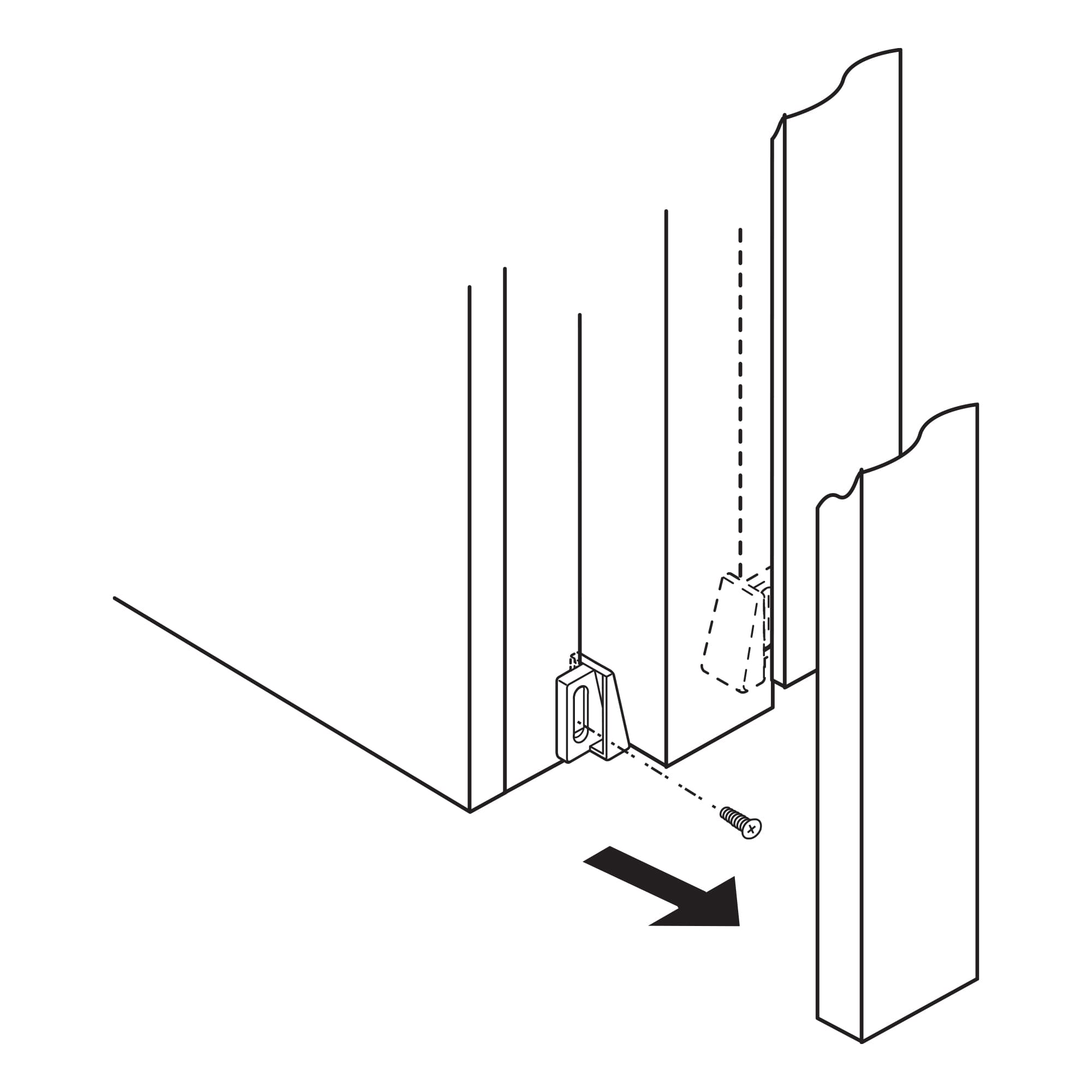How To:
Install a Pocket Door
Before You Begin
You will need the following tools for the installation:
- Hammer
- Level
- Hack Saw
- Wood Saw
- Miter Box
- Phillips Screwdriver
- Chalk Line
NOTE: This instructional guide is intended to be for general use; however, all components referenced are included in the Pocket Door Kit 164553, which is meant to be used on 24"- 36" x 6'8" doors.
Step 1: Measure

Calculate and measure the opening for your new pocket door.
Length
The rough opening should be 84-1/2" in height from the header (top of the opening) to the finished floor.
Width
To calculate the necessary frame door width, multiply the actual door width by two (2) and add 1".
Example: 36" x 2 = 72"; 72" + 1" = 73" opening
Step 2: Cut to Size

A. Place the template (A) at the top of the header assembly as shown in Figure A; fold at the dotted line over the edge and mark at the desired door size. Using a hack saw, cut both the wood and track.
B. Turn the header on the side; place the template (B) on the header sides and fold at the dotted line as shown in Figure B. Mark at the desired door size and cut the header sides only. Turn the header over and repeat on the other side.
NOTE: You won't need to cut if your door is 36"; all other sized doors will need to be cut using the templates included.
Step 3: Install Head Bracket

The adjustable head bracket can be installed onto the header assembly using 5/8" screws. Center the screw in the slot; the header assembly is now ready for installation.
Step 4: Mount the Jamb Bracket

On the door side of the opening, mount the jamb bracket to the stud at 81" from the bottom edge of the bracket to the finished floor using the 5/8" screws.
NOTE: Pre-mark the opposite side at 81" from finished floor
Step 5: Attach the Header

Insert the end of the header assembly into the jamb bracket as indicated. Raise the header to the pre-marked 81" or until level.
Attach, but do not tighten, with 5/8" screws. If the head is loose in the opening, adjust the head bracket to expand to fit firmly into the opening.
Tighten the screw securely in place. Mark the finished floor with chalk lines as indicated in the illustration.
Step 6: Secure Spreader Plate

Using nails, secure the spreader plate to the pair of split studs. Duplicate this step with the split jamb.
Step 7: Secure the Stud and Jamb Assembly

Using the chalk lines as a guide, place the split jamb assembly (A) against the header side and secure using 1-1/4" drywall screws. Using a level or plumb line, ensure vertical positioning and secure to the floor with nails.
Duplicate this step for the split stud assembly (B) by centering it between the jamb assembly and the rough stud.
NOTE: If on masonry floor, secure using industrial adhesive or concrete anchors.
Step 8: Install the Bumper End

Install the bumper to the end stud as illustrated.
NOTE: The front edge of the door should extend beyond the split jambs by the thickness of the trim you will use after installation. This may require you to shim the door bumper to allow proper stopping distance.
Step 9: Prepare the Face Jamb

Use the support board and temporarily toe-nail it to the split jamb. Rest the back end of the board on the bumper, but DO NOT nail it to the split stud. This will offer support for the assemblies while applying the wall covering.
After attaching the toe-nail board, add the face jamb (not included) to the jamb assembly.
Step 10: Install Face Jamb & Head Finish

Cut the face jamb to length. Install the face jamb against the stud, shimming to adjust the door opening for the plumb.
The width of the door opening should not exceed the door width by more than 3/16". Size and cut the head finish to the door opening size; attach the head finish to the head sides using three 1" drywall screws flush to inside the edge as shown in separate head detail.
The pocket door frame is now ready for wall covering.
Step 11: Install the Hangers

Place the hangers in the track and fit them through the space between track and jamb.
Step 12: Install Hanger Brackets to the Door

Mount the hanger brackets to the top of the door, 2-3/4" (7 cm) from the edge of the door to the center of the bracket.
NOTE: Install any sliding door closet pulls, pocket door pulls, or pocket door privacy lock and pulls prior to the next step.
Step 13: Mount the Door

Lift the door and insert the adjusting bolt into the slot of the bracket until it's properly seated. Continue to turn the adjusting bolt (using the supplied wrench) until the door reaches level and is aligned. Tighten the lock nut down against the bracket and adjusting bolt as shown.
Step 14: Install the Floor Guides

Attach the floor guides to the face jamb as shown. The door should be centered in the pocket.
Step 15: Install the Trim

Following steps 1 thru 4 on the right, install the finished trim to the header. Fasten the finished jamb header on the adjustment side of the door with screws to allow future removal and adjustment.
NOTE: There must be a MINIMUM 3/16" clearance between the finish trim and door

Once installed, the trim and header's should look like the image shown (left).
Congratulations, your pocket door is now installed and ready for work!